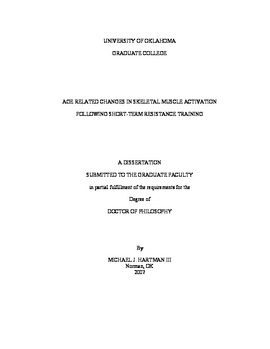| dc.description.abstract | Current research suggests that older adults do not possess the same ability to fully activate skeletal muscle of the lower limb as do young adults. However, it is not known at what age these changes may negatively affect the improvement in neuromuscular activation associated with resistance training. Purpose. To determine the effects of short-term resistance training on measures of muscular strength and skeletal muscle activation of the triceps surae in adult males ranging from 20-79 years of age. Methods. Forty-six normal healthy males volunteered to participate in this research study. Subjects were designated into one of five groups, classified as individuals aged between 20-29 years (n=10), 30-39 years (n=10), 40-49 years (n=7), 50-59 years (n=9), and 60-79 years (n=10). Subjects participated in three supervised resistance training sessions over the course of seven days, performing four lower body exercises during each training session. Subjects were assessed for muscle cross-sectional area, muscular strength, and muscle activation via twitch interpolation and surface electromyography (SEMG) before and after the experimental training. Three-way and two-way repeated measures ANOVA, as well as a one-way ANOVA, was used to determine group differences and changes with training. Results. Analysis of baseline muscular strength data revealed only a significant difference (p=0.02) in muscle strength between Group 2, 30-39 years (132.4 +/- 5.4) and Group 5, 60-79 years (99.8 +/- 7.5) for plantarflexion maximal strength. No significant differences (p>0.05) were observed for muscle cross-sectional area, dorsiflexion muscular strength, muscle activation assessed via twitch interpolation, or antagonist co-activation between age groups. Statistical analysis revealed no significant differences (p>0.05) in SEMG RMS amplitude or median frequency between age groups. However, comparison of muscle groups revealed a significant difference (p=0.003) in RMS amplitude between the soleus (SOL; 145.8 +/- 10.2 muV) and medial gastrocnemius (MG; 254.2 +/- 17.7 muV) muscles. Following training, there was no significant change (p>0.05) in muscle cross-sectional area, muscular strength, muscle activation assessed via twitch interpolation, or antagonist co-activation for any age group. Examination of SEMG data determined significant main effects for muscle group (p=0.001) and time (p=0.013) between SOL and MG for RMS amplitude. A significant decrease for the time main effect (p=0.001) in SEMG median frequency was also observed post-training. Conclusions. A similar pattern of response in all groups was observed in most variables assessed during the present study. The results from the present study indicated that there were no significant pre-test to post-test changes in muscle size, muscular strength, muscle activation, or antagonist co-activation following the experimental training period. These findings were unlike those from previous investigations of the leg extensors t hat have reported increases in performance after only two or three training sessions. This information may be useful for those involved in rehabilitative programs. Specifically, the muscles of the lower limb (i.e. calf) could require more than three training sessions to elicit the strength improvements and neuromuscular adaptations that typically occur during the early stages of a resistance training program. | en_US |
